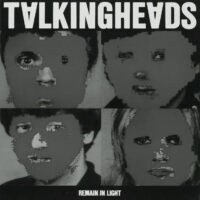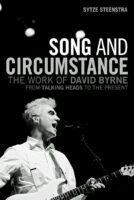Dubbing
Essay published in: Karin Templin (ed.), Street Architecture, HvdHA Amsterdam, 2018
 Anti-individualism was a big thing in the New Wave music of my youth. My generation was done with the virtuoso of the instrumental solo and the stardom of their creators. Perhaps it was because we found the endless electric guitar monologue even more boring than the bass solo.
Anti-individualism was a big thing in the New Wave music of my youth. My generation was done with the virtuoso of the instrumental solo and the stardom of their creators. Perhaps it was because we found the endless electric guitar monologue even more boring than the bass solo.
Striving for anti-individualism or impersonality, the New York band Talking Heads, reached its peak on its Remain in Light album. The album was inspired by traditions in African music, which differs different from much of Western European music in that there is no prescribed hierarchy, and diverging perspectives are possible. Music is performed as call-and-response and solo-and-circle in which the difference between performer and audience becomes unclear. The music depends on the contribution of all those present, often by the clapping of hands to the rhythm. African music is the product of engagement, whereas European music, with its bias on aesthetic pleasure, traditionally keeps its distance from public participation.
Those precise phenomena were challenged in the New Wave music of the late 1970s and early 80s as seen in the adoption of an intellectual approach to the recording of Remain in Light by the Talking Heads David Byrne and the producer Brian Eno.
The Talking Heads were joined by a number of guest musicians who were also familiar with African music. While Byrne and Eno studied musical theory, the various band members explored their fascination for the practice and techniques of African music. Keeping a safe distance from the intellectualism of Byrne and Eno, they were ready to perform, well before the songs had been refined for recording. ‘I didn’t read those books’, bass player Tina Weymouth said. The eventual recording of the album was unorthodox at the time. Byrne did not ask the musicians to rehearse finished and composed songs, but rather asked them to rehearse their skills. The album developed through a process of searching, recording in layers, dubbing, editing and erasing tracks. Literal African references gradually faded with guitar player Adrian Belew producing scratching rhinoceros-like sounds, which did not relate to any such references. The album contains songs in which different musical lines strands seem to converge. Lyrics appear to come from isolated voices framed by heavy rhythms. They are fragments of facts and messages: ‘Live facts, not fictions’, Byrne said.

Comparing music to architecture tends to neglect or obscure the specific features of both arts. Striking in the Talking Head’s experiment is the emphasis on the working method and the analogy with current design practice in which design teams increasingly work on a single digital model. Unlike those produced at the drawing board, digital drawings are no longer signed by the draughtsmen. The changes induced by such design methods result in interesting new models. Rather than traditional methods which develop from the visionary hand sketch to the accurate working detail, current architectural design methods are characterized by the ongoing editing of different layers in the design, of the diverging contributions of different people, from solid bass player to front man, from brick layer to project manager and from designers to end users. Projects are directly drawn on the 1:1 scale while traditional design stages lose their meaning. Changes can be made very easily and, importantly, can be changed consistently throughout the entire project. It has become possible to design a building according to the terms that their techniques and materials presuppose. Contributions to the design model may at times be pragmatic and technical, at others aesthetic, and still at times intellectual or ideological in nature. Naturally, there is a mix of craft, routine and enthusiasm. Today, design is continuously measured against intellectual and physical objectives as well as practical possibilities, and above all, is liberated from the vision of a single author.
If architecture aspires to a degree of street credibility it is clear that buildings are no longer the self-evident product of regional construction techniques or the availability of locally sourced materials. Anything is possible, always and everywhere. Little has been reflected on the change that the working on large singular digital models might mean for architectural methodology. However, the possibility of dubbing, changing and editing projects can be researched more closely for what they might mean for design methodology. My suggestion is that the dubbing methodology that goes with this practice can be made productive in the design for street credibility- for street architecture. The continuous dubbing of design choices at all scales and project stages offers a strong alternative to a practice that depends on singular choices. In the context of volume house building these singular choices simply do not exist in the first place. The strategy of editing and dubbing given construction systems, standard products and materials is crucial in housing design. Quality management largely depends on the exchange of electronic data with contractors and their subcontractors. Unique solutions are the result of design intent, just as much as of the specific features of their physical, social and economic context. That is why projects ultimately always look different.
Today, a contextual approach of design is a choice, not an inevitability. This helps to explain how easily contextualism degenerates into a practice of cultivated artistry and individualism, in which architects take the liberty to ‘read’ the architectural context in their own fashion and subsequently edit that context. Ultimately, even the work of a Rationalist architect like Aldo Rossi is consciously subjectified. One could argue that Rossi achieved integration of the physical urban context in a vertical way, between the context and the design task we find the personal creativity of the designer. The analogue city from which Rossi took inspiration was a highly personal reservoir of references. Byrne’s impersonal dubbing methodology seems more productive to me, because by nature it is the result of shared action. Such dubbing can be transformed into a method of architecture as a horizontal, rather than vertical, integration of the design context. The concept of Street Architecture is amplified to an intellectual and social environment, in which design stays strictly architectural and the architect plays an old card of the profession: the ability to order complicated tasks rationally and to supply them with comprehensible solutions.
Literature
Sytze Steenstra, Song and Circumstance, The Work of David Byrne form Talking Heads to the Present, Continuum, 2010
Jonathan Lethem, Fear of Music, Continuum, 2012
David Byrne, How Music Works, Canon Gate, 2012


